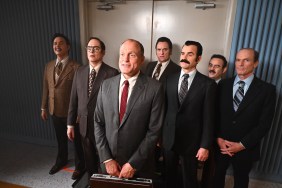
SHOCK celebrates 3D horror classic HOUSE OF WAX on the anniversary of its release.
“Everything I ever loved has been taken away from me , but not you my Marie Antoinette for I will give you eternal life…”
So says Professor Henry Jarrod, the disfigured and now maniacal sculptor in director Andre de Toth’s classic and influential 1953 3D horror film HOUSE OF WAX, spoken after his beloved wax museum and all of his creations are burned to the ground by his craven partner in a bid to cash-in on the insurance money.
Jarrod is played by then Hollywood character actor Vincent Price, who would with this film, sew the seeds for his enduring epitaph as one of the leading stars of horror films. Prior to HOUSE OF WAX (released on this day, April 25th, 1953), Price had starred in the odd fantastical film (1940’s THE INVISIBLE MAN RETURNS and 1946’s SHOCK come to mind) but it was here that he let loose his persona, allowing the scenery chewing, marvelous ham in him to emerge and embody both incarnations of Jarrod, first as the kindly, visionary and sensitive artist and then, as the deranged angel of waxen death.
Starring as Price’s deaf and dumb manservant Igor (nothing subtle here) is future action film legend Charles Bronson, billed here under his birth name Charles Buchinsky. Price and Bronson would later re-team, matching wits and wills in 1961’s science fiction fantasy yarn MASTER OF THE WORLD, wherein Bronson, now a quasi-star, would use his newly minted stage name.
Also drifting through HOUSE OF WAX’s dripping perimeter is actress Carolyn Jones, later to be immortalized as Morticia Addams, here playing Jarrod’s wicked ex-partner’s fiancee Cathy, a lady whom the homicidal sculptor murders, entombs in paraffin and mounts as his Joan of Arc exhibit.
HOUSE OF WAX is a revolutionary film. 3D had been around since virtually the dawn of cinema, but it wasn’t until Arch Obler’s 1952 3D film BWANA DEVIL that the technique was employed in a feature. DEVIL was an independent production and, so impressed by its success, Warner Bros. stepped up to produce and release HOUSE OF WAX, making it the very first 3D studio feature film. WAX used the cumbersome technique of running to projectors concurrently, each film representing the view of either the left or right eye and then, decoded by the audience using special polarized glasses into a thrilling 3D image.
More 3D films followed suit but the technique was soon deemed a gimmick and, in addition to its painstaking exhibition process, the fad soon faded. Of course, with TV starting to filter into living rooms across the globe, 3D was just one of many attempts by the film industry to woo viewers back to the cinemas.
Despite the odd 3D film appearing over the next three decades, the trend wouldn’t swell again commercially until the early 1980s, when a new way of exhibiting 3D using a “split stereo” image on a single 35mm filmstrip could be run through a projector with a special lens, again decoded by its cardboard glasses-wearing audience. Like TV was during the previous 3D wave, home video was the new enemy of Hollywood and 3D was once more promoted as a theatrical experience you couldn’t get at home. Amidst the wave of 3D films of that period, HOUSE OF WAX was re-released again in this process, blowing people away again, with its delightfully invasive “paddle ball man” and Can-Can girl gags.
3D died once again, when audiences tired of having their noses pinched by the uncomfortable glasses but emerged again several years ago, this time as an answer to audience downloading and bootlegging, and, with its improved digital technology in both photographing and converting, 3D has never gone away and is likely here to stay.
Recently released on 3D Blu-ray via Warner Home Video, HOUSE OF WAX is perhaps the best 3D film ever made. It perfectly balances its story and “look” with wonderfully shameless “comin’ at ya” gags and boasts that aforementioned, career foreshadowing performance by the late, great Price.
Famously, however, despite the movie being such a rousing technical success, director De Toth could never appreciate his work, either during its making or its exhibiting: Andre De Toth only had one eye!
HOUSE OF WAX
-
Waxhouse7

-
Waxhouse10

-
Waxhouse9

-
Waxhouse5

-
Waxhouse2

-
Waxhouse3

-
Waxhouse4

-
Waxhouse6

-
House of Wax 3D RR Quad










